★★★★★

 I usually start watching this in a sense of disbelief, since it’s certainly not the most immediately convincing of movies. However, there’s a point near the middle which has in quick succession an amazing action sequence and two revelations, one touching, one tragic, and I realise that I am, yet again, utterly buying into the characters, storyline and setting. Disbelief simply ceases to be an option, and by the end, I know why this is among my all-time favourites, not just in the action heroine genre, but among all cinema.
I usually start watching this in a sense of disbelief, since it’s certainly not the most immediately convincing of movies. However, there’s a point near the middle which has in quick succession an amazing action sequence and two revelations, one touching, one tragic, and I realise that I am, yet again, utterly buying into the characters, storyline and setting. Disbelief simply ceases to be an option, and by the end, I know why this is among my all-time favourites, not just in the action heroine genre, but among all cinema.
While you can’t pin this down into any genre, it’s probably the intensity which carries the film. No-one does anything in half measures, be it love, hate, kidnap babies or eat their own severed fingers. The film captures the comic-book at its most primordial: good vs. evil, told in bold strokes and capital letters. SHAZAMM! “Evil”, in this case, is a demonic eunuch – looks male, sounds female – who is collecting baby boys whose horoscopes have them destined to be emperors, in order to rule and, er…the usual bad guy stuff. He is assisted by Invisible Girl (Yeoh), whom he has brainwashed into stealing an invisibility cloak from her inventor husband. It doesn’t work in sunlight, however, which is the only thing stopping our villain from executing his plan.
For the forces of good, we have Wonder Woman (Mui), a policeman’s wife with a secret identity, and Thief Catcher (Cheung), a bounty-huntress who gets involved after she accidentally kills a baby while trying to lure the kidnapper out. She and Invisible Girl were childhood pals, and also knows that the three must join forces to have a chance of stopping the Big Bad. The casting is perfect: Cheung the perky optimist, Yeoh the tormented control victim, and Mui the calm and quiet wife with a secret. [There are suggestions the three represent China, Hong Kong and Taiwan – which is which, I leave up to you] Credit is also due to the rest of the cast, notably Wong as the wordless evil henchman, with a taste for self-cannibalism, small birds and a fatal flying guillotine.
The action, choreographed by Chinese Ghost Story director Ching Siu-Tung is also spot on, though one suspect doubles were used for chunks. Particularly at the finale, there are times when the effects do over-reach themselves, and a little less ambition might have been wise. But the fact that everyone takes it completely seriously helps a great deal, though there are still question-marks over the plot: are the baby hostages safely rescued or not? At one point, Thief Catcher chucks a few sticks of dynamite into the villain’s nursery, saying the infants are hopelessly corrupt – not something you’ll see in any Hollywood movie! But at the end, the TV shows parents who look rather happier than you’d expect if they were being handed a plastic bag full of bits.
Still, it’s not often a film manages to run the entire gamut of emotions. Inside 87 minutes, you get laughter, tears, moments both “awww” and “eugh – gross!” (that’ll be Anthony Wong), thrills, chills and enough flamboyant style to power several graphic novels. It wasn’t that big a hit at home, taking less than HK$10 million at the box-office (in comparison, the biggest Hong Kong film of 1993, Stephen Chow’s Flirting Scholar, took over HK$40m), but its cult status in the West is entirely justified. Be sure to avoid the horrific dubbed version though – indeed, be sure to avoid the horrific trailer too.
Dir: Johnnie To
Stars: Maggie Cheung, Anita Mui, Michelle Yeoh, Anthony Wong
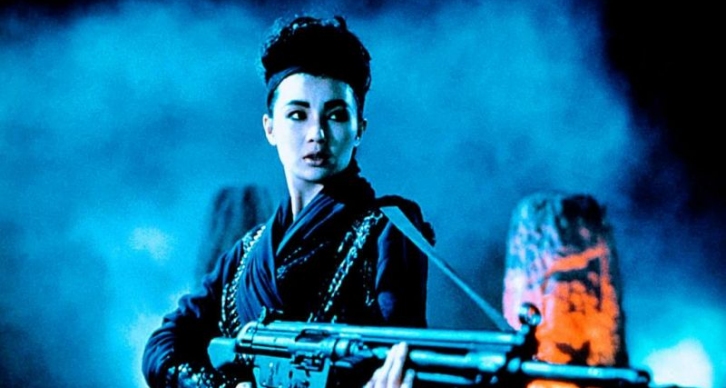





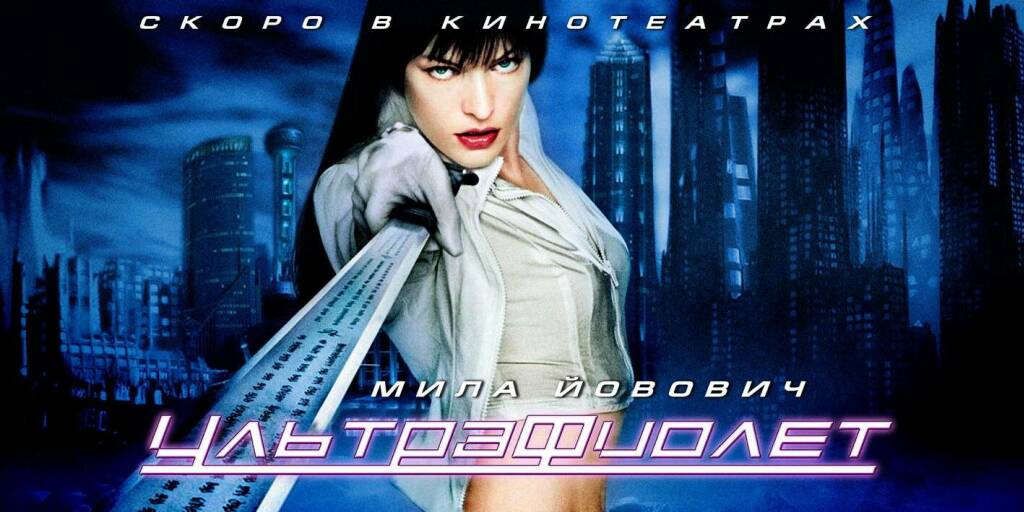 ★★★★½
★★★★½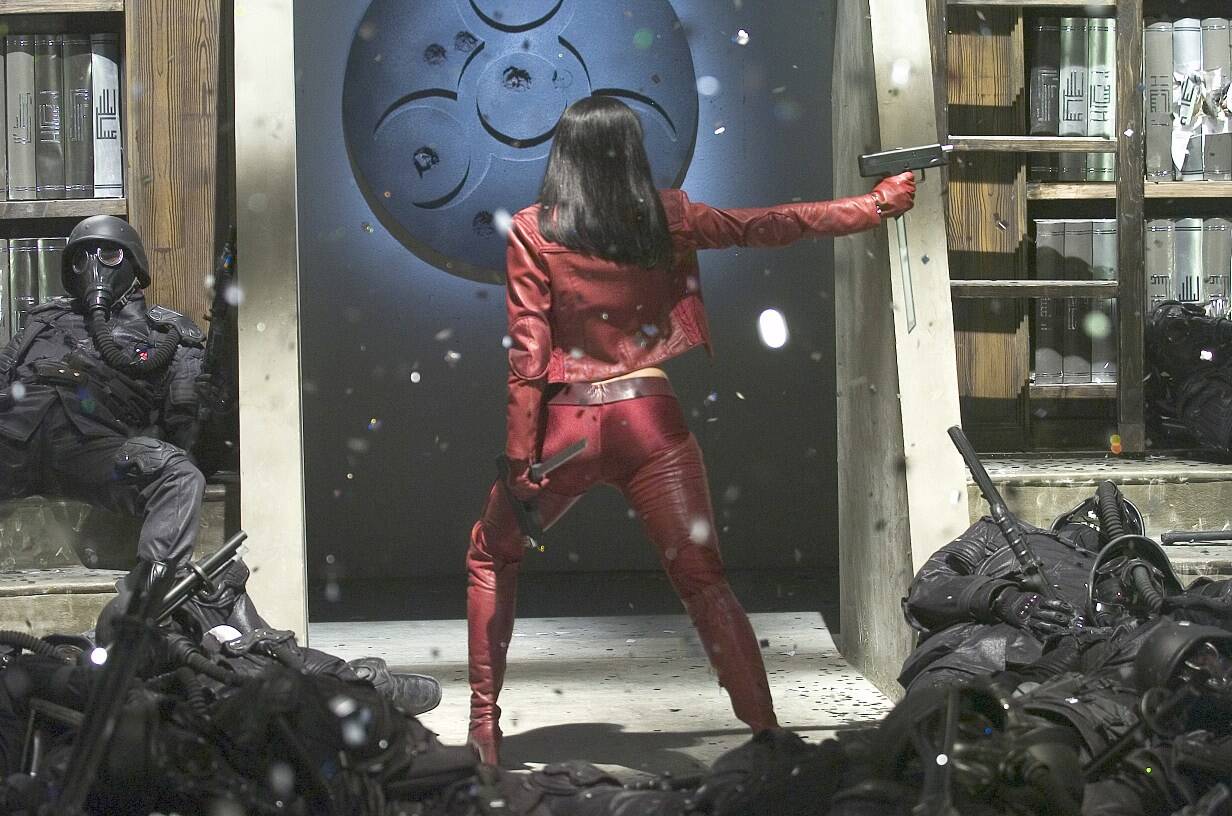 As with Resident Evil, the main asset is Jovovich, who projects just the right mix of chic bad-ass – her belly-button gets so much screen time, it deserved its own credit – with wardrobe and hair changing colour in synch with her mood [and, I believe, it’s far more likely nanotech will be used for this kind of thing than, say, curing cancer] When her co-vampires prepare to take her on, pointing out they’re just as fast and strong as she is, her response is, “Yeah, but are you as pissed-off as I am?”. It’s hard to imagine any other actress who’d come out with such a cheesy line and get away with it.
As with Resident Evil, the main asset is Jovovich, who projects just the right mix of chic bad-ass – her belly-button gets so much screen time, it deserved its own credit – with wardrobe and hair changing colour in synch with her mood [and, I believe, it’s far more likely nanotech will be used for this kind of thing than, say, curing cancer] When her co-vampires prepare to take her on, pointing out they’re just as fast and strong as she is, her response is, “Yeah, but are you as pissed-off as I am?”. It’s hard to imagine any other actress who’d come out with such a cheesy line and get away with it.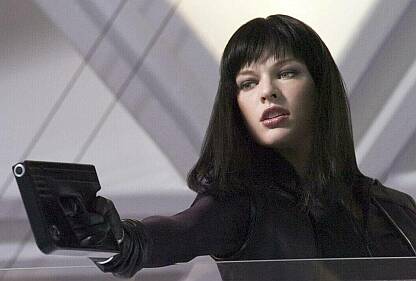 Otherwise, however, the action is excellent, CGI enhancing the impact of the fights. There is a certain sameness, it must be admitted – Violet faces multiple opponents and kicks their arses from here to next week – but Wimmer takes this basic theme and runs enough variations on it that it doesn’t become boring. Visually, it is hard to work out where the sets stop and the plentiful effects work begins (to some extent, that’s true of the supporting cast as well, who don’t have really have much to do, and may be avatars). Either way, it looks fairly good, given the budget: as noted, it isn’t going for photorealism, though the motorcycle chase did look more like an Xbox game. But even little things like disposable mobile phones, indicate genuine thought has gone into the edges. Perhaps more so than the plot, truth be told.
Otherwise, however, the action is excellent, CGI enhancing the impact of the fights. There is a certain sameness, it must be admitted – Violet faces multiple opponents and kicks their arses from here to next week – but Wimmer takes this basic theme and runs enough variations on it that it doesn’t become boring. Visually, it is hard to work out where the sets stop and the plentiful effects work begins (to some extent, that’s true of the supporting cast as well, who don’t have really have much to do, and may be avatars). Either way, it looks fairly good, given the budget: as noted, it isn’t going for photorealism, though the motorcycle chase did look more like an Xbox game. But even little things like disposable mobile phones, indicate genuine thought has gone into the edges. Perhaps more so than the plot, truth be told.









































 ★★★★
★★★★ But to quote one character in the movie, “Bitches from
But to quote one character in the movie, “Bitches from 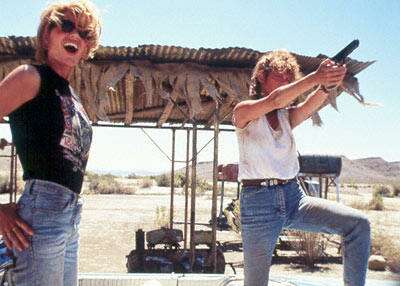 It becomes like having Andrea Dworkin yelling in your face for two hours, yet the film’s moral is that if women empower themselves, death inevitably results. Khouri seems to be saying, “You can only beat the system by suicide,” while the patriarchy watches from behind its sunglasses and firearms. We
It becomes like having Andrea Dworkin yelling in your face for two hours, yet the film’s moral is that if women empower themselves, death inevitably results. Khouri seems to be saying, “You can only beat the system by suicide,” while the patriarchy watches from behind its sunglasses and firearms. We 
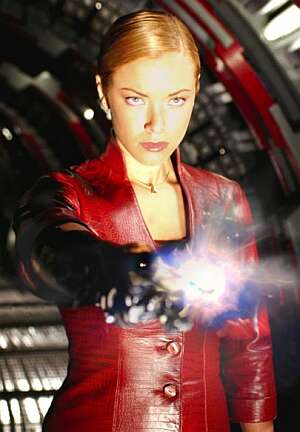 I feel a certain camaraderie with Arnie, since I’ve largely grown up alongside this series of movies, which is probably his finest work. I was at university when the first one came out; the second saw me living the life of a bachelor in London; and the latest installment finds me a happily married man in Arizona. Just as I’ve evolved, so have his opponents: they’ve become harder, faster and more difficult to kill; my sarcasm has been honed to a lethal edge, thanks to living with two teenagers and a pair of dogs.
I feel a certain camaraderie with Arnie, since I’ve largely grown up alongside this series of movies, which is probably his finest work. I was at university when the first one came out; the second saw me living the life of a bachelor in London; and the latest installment finds me a happily married man in Arizona. Just as I’ve evolved, so have his opponents: they’ve become harder, faster and more difficult to kill; my sarcasm has been honed to a lethal edge, thanks to living with two teenagers and a pair of dogs.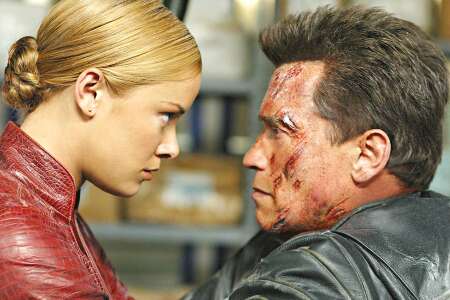 The plot is effectively a retread of the previous entry, with John Connor (Stahl) a drug-confused member of the underclass since his mother died of leukemia (possibly Hollywoodese for “Linda Hamilton wanted too much money”). He goes on the run with former schoolmate Kate (Danes), whose father just happens to be the guy in charge of SkyNet. What are the odds against that? These two are supposed to meet and fall in love, but there’s a bump on their road to happiness, in the shape of a nuclear war due to start at 6:18 pm that night.
The plot is effectively a retread of the previous entry, with John Connor (Stahl) a drug-confused member of the underclass since his mother died of leukemia (possibly Hollywoodese for “Linda Hamilton wanted too much money”). He goes on the run with former schoolmate Kate (Danes), whose father just happens to be the guy in charge of SkyNet. What are the odds against that? These two are supposed to meet and fall in love, but there’s a bump on their road to happiness, in the shape of a nuclear war due to start at 6:18 pm that night.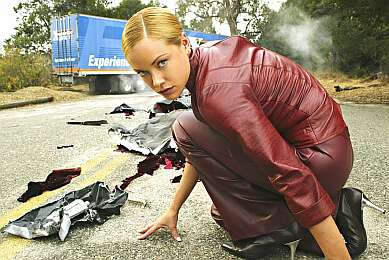 One interesting point, is that nobody ever mentions the T-X’s gender. The concept certainly held potential for a lot of PMS-type comments, but save for one minor joke involving Victoria’s Secret, sexuality is entirely kept out of things. The T-X, with her impossibly perfect hair and the coolest red leather jacket worn by a actress playing a superviolent female robot since Eve of Destruction, just goes about her business like an evil babysitter.
One interesting point, is that nobody ever mentions the T-X’s gender. The concept certainly held potential for a lot of PMS-type comments, but save for one minor joke involving Victoria’s Secret, sexuality is entirely kept out of things. The T-X, with her impossibly perfect hair and the coolest red leather jacket worn by a actress playing a superviolent female robot since Eve of Destruction, just goes about her business like an evil babysitter.